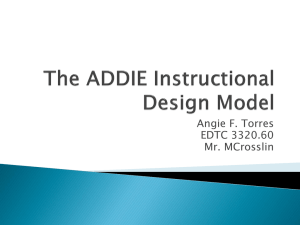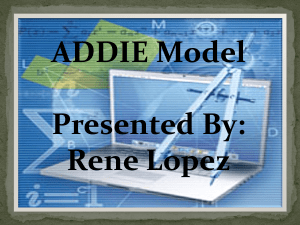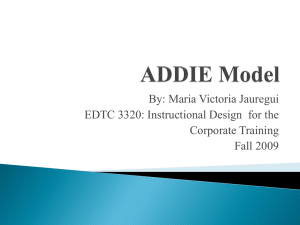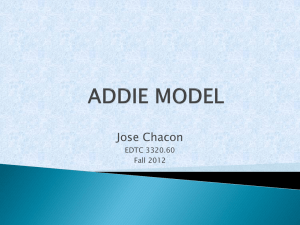LIS672 Learning Theories
advertisement
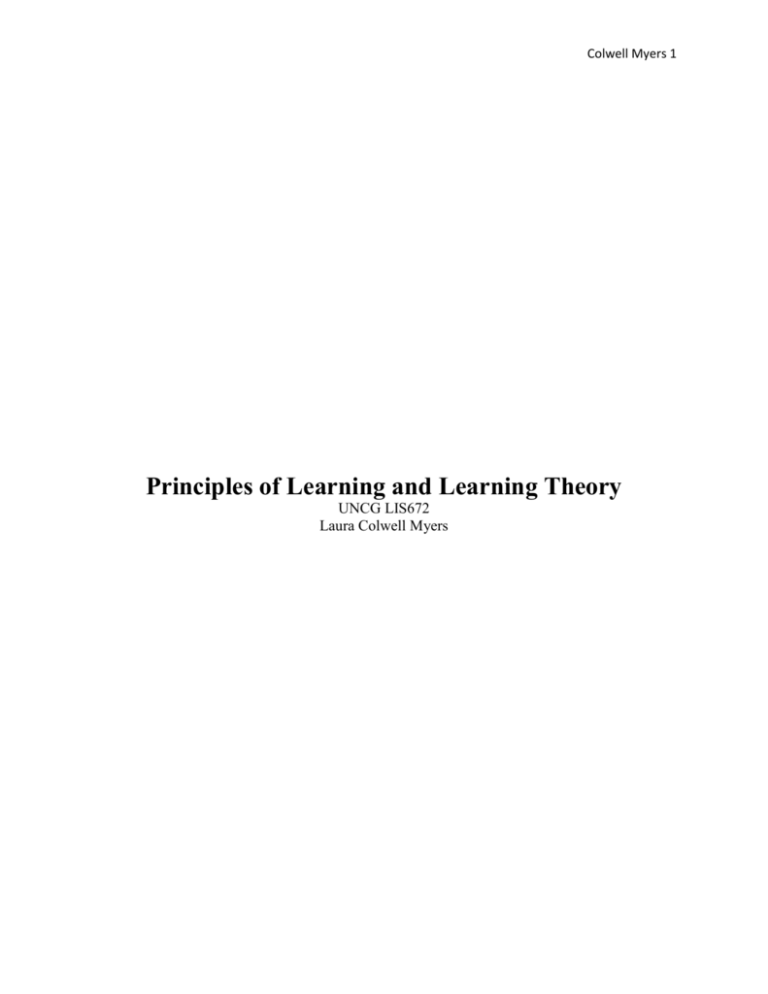
Colwell Myers 1 Principles of Learning and Learning Theory UNCG LIS672 Laura Colwell Myers Colwell Myers 2 Principles of Learning and Learning Theory The question, what is learning, is a difficult question to ask and define. Learning is the ability for a student to take away information after an instructional session. The ultimate goal for an instructor is to teach effectively enough so that the material is transferred to the long term memory, instead of the short term memory. Because the question is broad, there are three learning theories; Behaviorism, Cognitivism, and Constructivism, which are different viewpoints that define what learning is as a whole. Behaviorism is the first major learning theory. The theory of Behaviorism focusses on a change in observable behavior. Nietfeld explains that voluntary and involuntary behavior is the genetic make-up of behaviorism (Nietfeld). Involuntary behavior is an emotion that cannot be controlled. An example would be an increased heart rate due to a phobia of spiders. The subject is unable to control their emotions, leading to the behavior they are experiencing. A theoretical example would be Pavlov and his use of Classical Conditioning in dogs. By using a conditioned and unconditioned stimulus, the dogs salivated resulting in a conditioned and unconditioned response. Basically, by using meat and an unconditioned stimulus, Pavlov was able to control the behavior of the dogs, without them knowing. The opposite behavior is voluntary behavior. Voluntary behavior is more common in the education field. Nietfeld describes Operant Conditioning, by BF Skinner and the use of punishment and reinforcement. In the education field, positive reinforcement promotes a positive behavior, which ultimately keeps students more engaged. The second major learning theory is Cognitivism. The Cognitivist theory appears to be the opposite of the Behaviorism theory. Behaviorists focus on external reactions and emotions, while Cognitivists focus of how people “think, understand, and know” internally (Peoplelearn- Colwell Myers 3 Asia University). Ultimately, the way information is processed and received is the major concern for Cognitivists. Asia University illustrated the Information Processing Model and how information must pass through the sensory memory and the short term memory, to get to the long term memory. In the education field; the goal is to get material and information to the long term memory, instead of the short term memory. Long term memory will allow for new material to become “easier.” This is because students are more likely to familiarize the new subject, with something that has previously been learned. On the other end of the spectrum, the short term memory can be jammed with material that has been memorized for a one-time use. The theory of Constructivism is the final learning theory. According to the Concept to Classroom text, Constructivism is a theory based around how people learn, based on observation and study. In the education field, this theory allows students to basically teach themselves. The activities are hands-on, so that students can work through the issues they are experiencing, experiment with new ideas, and reflect on the activity as a whole. This theory allows students to become engaged in what they are doing and tie the new material to previous knowledge. An example of this theory would be a Rube Goldberg machine experiment. Students learn about the theory, then must take that knowledge, apply it, and create a machine that works effectively. The three learning theories are unsuccessful without teaching. Teaching is the idea of putting information into action. Ultimately, teaching facilitates learning. In order for an instructor to reach the end goal of learned material, they typically follow an instructional process. An instructional process is the design, development and the delivery of material through students. This can be achieved by using instructional design models. According to the Instructional Design Models and Methods, there are multiple models that can be used to teach a lesson. These models include Merrill’s First Principles of Instruction, Colwell Myers 4 the Addie model, the Dick and Carey model, Kemp’s instructional design model, Gagne’s Nine Events of Instruction, Bloom’s Learning Taxonomy, Kirkpatrick’s 4 Levels of Training Evaluation, and Cathy Moore’s Action Mapping. These instructional design models all vary based on the type of learner and learning style being targeted. The most familiar and commonly used instructional design is the Addie model. The Addie Model is an instructional model that encompasses everything that a lesson should portray and achieve, in terms of planning, guiding and achievement. The steps of the Addie Model include analysis, design, development, implementation, and evaluation. The first step of the Addie model is analysis, or the identification of the problem. During this step, the teacher identifies the issue and establishes goals for the student’s to overcome. Typically on a lesson plan, a teacher will note it as a “learning objective” and at the end of the lesson, “My students will be able to…” The design stage of the Addie model is probably the most important. Design is essentially the frame-work for the lesson. Because design is so important, Robert Gagne’s nine events of instruction are normally used. The steps include gaining attention of the students, informing the learner of the objectives, recalling prior knowledge, presenting the stimulus or lesson, providing learner guidance, elicit performance, provide feedback, access performance, and enhance retention transfer (Instructional Design Models and Methods). The development stage in the Addie model is the actual construction of the lesson material. The instructor takes the elements they laid out in the design stage to create the material needed to reach the outlined goals. The development of a lesson can range from textbook learning to the incorporation of technology; it depends on the instructor and their vision for the lesson. Colwell Myers 5 The fourth step in the Addie model is the implementation of the lesson. The instructor presents the material to the students and allows them to engage in the activities that have been prepared. To test how well the student’s understood the material, the instructor will perform evaluations at the end of the lesson. Evaluation in the Addie model is composed of Summative and Formative assessments. According to the article, Formative and Summative Assessment, by Evelyn Johnson and Joseph Jenkins, “assessment is the use of a variety of procedures to collect information about learning and instruction.” Essentially, evaluation is a way to gauge how much or how little a student learned during the course of the lesson. Summative assessments are more of a formal approach. A teacher is able to see what a student learned by course grades, standardized testing, and end of unit projects. In my own career, I have been in the role of a library assistant for multiple years. For starters, my role as a library assistant at Wingate University was instructional in an academic sense. We were the first point of contact with reference questions and computer questions. Because a University is based on learning, we, as library assistants, were unable to do the work for a student. We would talk them through how to access data so that they would be able to complete in on their own the next time. Following the academic library, I was moved to a public library, where most of the instruction I provided was based around EBooks. We would demonstrate how patrons could access EBooks from our database or from their device. In the future, I hope to work as a reference librarian in a University. There, I hope to be the instructional librarian that will teach new students how to use library databases offered by the University, instead of search engines like Goggle. Colwell Myers 6 For my example, using the Addie model, I chose to teach how to use a GPS watch. Because I use the Garmin Forerunner 305 on the daily basis for running, I decided to provide instruction because it can be complicated to use, especially if you are on a different training plan, other than strictly running for a set amount of time. By starting with the analysis step of the Addie Model, I will identify the learning goals of the student. By the end of the lesson, the student will be able to identify the key features and parts of the Garmin Forerunner, successfully monitor your heart rate, and calculate and monitor lap records in an indoor facility. Although the Garmin Forerunner has other features, the goals listed above will allow a beginner to use the watch effectively from the start. For the design stage, I will be using Gagne’s nine events of instruction. To gain attention I hope to show a video of someone running, that feels like they have been running forever. But, with a GPS watch, they have only run .2 miles. Then I will emphasize the learning objectives listed above. Following that step, I will recall prior knowledge by discussing the different keys on an Xbox controller or a computer. This will be relatable to the functionality of a GPS watch. Using PowerPoint, I will introduce the lesson using visual examples as well as guided instruction on how to use the watch. The development phase of the Addie model will be creating the PowerPoint with images of the watch as well as an example lesson. The implementation model of the lesson will be seen more thoroughly in the presentation. For evaluation, I would provide the student’s with a diagram of the watch. Using a word bank, I would allow them to match the words to the appropriate part on the watch. Typically, if students are aware of where the feature is, they will be more likely to use it. In a classroom setting, I would like to take the student’s outside on the track to use the lap feature. By having Colwell Myers 7 them walk around the track, they will be able to monitor their lap pace and speed. This would also allow a more hands-on approach. Another method of evaluation would be to have all students stand up and jump up and down ten times with the watch in their hand. After jumping, see if the students can locate where the heart monitor feature is located. The PowerPoint instruction will provide more detail and images to support the process. Colwell Myers 8 References "Constructivism as a Paradigm for Teaching and Learning." Constructivism as a Paradigm for Teaching and Learning. Web. 11 Feb. 2015. "Instructional Design Models and Methods | Instructional Design Central." Instructional Design Models and Methods | Instructional Design Central. Web. 20 Feb. 2015. Johnson, Evelynn, and Joseph Jenkins. "Formative and Summative Assessment." Formative and Summative Assessment. Web. 20 Feb. 2015. Learning Theories - Cognitive Learning Theories. "Learning Theories-Cognitive Learning Theories." Learning Theories - Cognitive Learning Theories. Web. 19 Feb. 2015. Nietfeld. "Behaviorism & Education." Behaviorism & Education. Web. 20 Feb. 2015. "Robert Gagne's Five Categories of Learning Outcomes and the Nine Events of Instruction." Robert Gagne's Five Categories of Learning Outcomes and the Nine Events of Instruction. Web. 20 Feb. 2015. "What Is Instructional Design? | Instructional Design Central." What Is Instructional Design? | Instructional Design Central. Web. 20 Feb. 2015. Yatvin, Joanne. "What Is Learning, Exactly?" Washington Post. The Washington Post, Web. 20 Feb. 2015.

